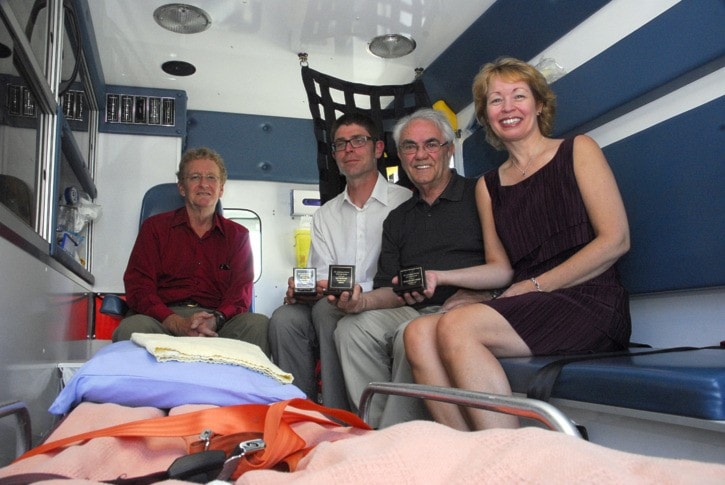If it weren't for Heather Ann McRae and Eugene Hahn being part of a minority group, Nicholas Woodiwiss wouldn't be alive to thank them for saving his life.
McRae and Hahn are among the only 15 per cent of British Columbians who know CPR – a task the pair of strangers performed on a cyclist who suffered cardiac arrest in their Saanich neighbourhood on July 4 at 11 a.m.
"I was driving down the street and a cyclist was coming up. And I saw he wobbled into the middle of the road and he just collapsed on his bike," said McRae, recalling the incident on Amblewood Drive in the Royal Oak area.
Hahn and his father-in-law, Gus McTavish, were on Hahn's front lawn when they heard the accident in front of the home.
"It sounded like a gasp, and a very familiar sound of a bike hitting the ground," says Hahn, an avid cyclist himself.
McTavish says once he and his son-in-law ran to the road, where they saw McRae coming to the cyclist's aid, he first thought she had struck him with her van. While Hahn called 911, McRae began performing CPR, assisted by McTavish.
"We saw (Woodiwiss) had fixed eyes, no pulse, no circulation, nothing was happening," McRae says. "He was turning blue – his lips, his upper ears. We knew we had serious issues."
It took nine minutes for the ambulance to arrive, during which time McRae and Hahn took turns with chest compressions. Another passing motorist, Brenda McPhail, stopped her car to assist, ensuring Woodiwiss's airway was clear.
"I learned CPR at 19," says Hahn, 40, who had never needed to use his skills prior to this incident. "I remembered landmarking – how to find the spots the press, and I remembered the rhythm – 15 (compressions) every 10 seconds or so."
Leanne Heppell, executive director of B.C. Ambulance Service, says the group's performance of "bystander CPR" prior to the arrival of an ambulance played an important role in Woodiwiss's surivival.
"Even with the best technology, medical expertise, and the timely deployment of paramedics, the best chance of survival is still bystander CPR," she says.
"The minutes following a cardiac arrest are vital," adds Pauline Park, superintendent for Vancouver Island's 911 dispatch centre. "If bystander CPR is performed immediately, the patient has a much better chance of survival without suffering any brain damage."
Hahn, McPhail, McRae and McTavish were all awarded Vital Link awards on Thursday (July 26), recognizing the bystanders' quick responses that helped save a life.
B.C. Ambulance Service, through the ACT (Advanced Coronary Treatment) Foundation, helps teach students and teachers CPR, including McRae, who works at Lochside elementary.
"I wish so many other people took (a CPR) course and knew what to do. We can all do this, we all have this at our disposal. It's a matter of not wasting time, because the person in front of you is dying," says McRae.
Woodiwiss, 61, knows he's lucky to be alive, and says other than a pain in his chest that feels like he "was in a boxing match" from the hard compressions, he's recovering well.
"This has made me want to do something, maybe help train kids in CPR," Woodiwiss says. "I can say, 'I would've been dead, but for someone knowing CPR.' I hope this motivates some people to learn the skill."
kslavin@saanichnews.com
